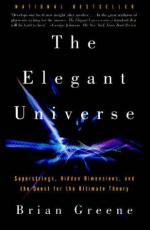
|
| Name: _________________________ | Period: ___________________ |
This quiz consists of 5 multiple choice and 5 short answer questions through Chapter Seven, The Super in Superstring.
Multiple Choice Questions
1. What characteristic of the string determines the properties of the particle it represents?
(a) Its mass.
(b) Its frequency of vibration.
(c) Its length.
(d) The number of other strings with which it is threaded.
2. What is the fundamental force responsible for keeping the nucleus of an atom "glued" together?
(a) The nuclear-strong force.
(b) Potential electrical force.
(c) Quantum-tunneling force.
(d) Gravitational force.
3. Which of the following is a correct statement, based on the theory of special relativity?
(a) Time and space are not experienced exactly the same by all observers
(b) Movement can only be measured relative to very massive objects, such as stars.
(c) Energy only exists relative to mass.
(d) Time is always the same to all observers, but space is not.
4. What is the quantum, or messenger particle, of gravity?
(a) The Calabi-Yau particle.
(b) The gravino.
(c) The graviton.
(d) The Einstein boson.
5. What rule did Max Planck discover the electromagnetic waves bounded in a container, such as an oven, must follow?
(a) The energies of all waves inside the over must cancel out to zero.
(b) They must have a whole number of peaks and troughs that fit perfectly inside the container.
(c) The frequencies of the waves must all be the same.
(d) There must be an even number of peaks and troughs.
Short Answer Questions
1. Why are the fluctuations that quantum physics predicts not observable in everyday life?
2. According to general relativity, the change that an object causes in the fabric of space-time depends directly on _____.
3. What is the Planck mass?
4. Which of the following is correct about the speed at which light moves?
5. In quantum mechanics, what is symmetry breaking?
|
This section contains 418 words (approx. 2 pages at 300 words per page) |

|




